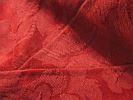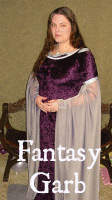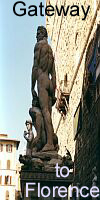


|
I wanted to make something a
little bit different, for attending
Midwinter Coronation, and came across these two images. Both are from
mid 1500s - around 1560ish, and appear to be reasonably 'simple' and
stylish.
Inspirations:
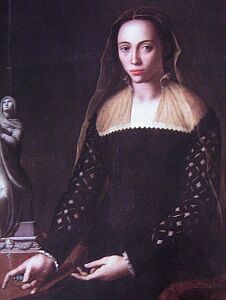 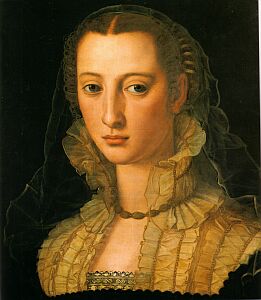
|
First
was the 1559 Bronzino's (possibly now attributed to Allori?) Portrait of a Lady, now thought to
be that of Guilia the illigitimate daughter of Allessandro Medici.
The second portrait is Portrait
of a Woman found in the Uffizi, dated around 1550-65 and
possibly by Alessandro Allori.
Both are Florentine from a similar timeline.
|
Details of the outfits:
- both are black or brown (colour of mourning in Florence at
the time)
- both have a similar neckline edging and are wide on the
shoulder
- both have a gold giorgeria, of varying complexity, with a
collar. Sumptuary laws, made by Cosimo, allowed for one gold
giorgeria (Moda a Firenze)
- both have apparently similar hairstyles and veils (married
women)
- both do not wear earrings (more common in Florence)
- Guilia' portrait has cutwork/slashed sleeves. The sleeves
cannot be seen in the Allori portrait.
- Guilia's sottana: waistline appears to be low ast the
front, possibly at the side(?). This is difficult to see clearly. Skirt
is possibly gathered (type of pleat is difficult to see) and 'flat',
not with a farthingale. This is consistant with Florentine fashion of
the time.
|
Research:
Evidence of other
'cutwork' or slashing can be seen, right, in the portrait of Clarice Ridolfi Altoviti by
Cristofanao Dell'Altissimo (1550-55). This is of a simlilar time-line
and is Florentine. Moda a Firenze gives
more information on this form of decoration being used. A detail of the
portrait, shows the sleeves are also decorated with cutwork. (picture
enhanced).
|
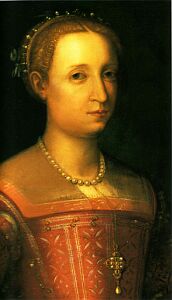 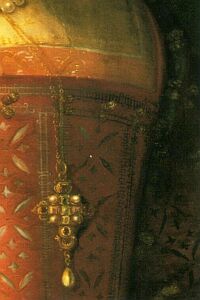
|
|
The final picture
(B&W), I found on Jen Thompson's Festive
Attyre,
is by unknown Italian artist (?) which is very similar in style to the
portrait of Guilia (exceptions: baragoni and fuller skirts so possibly
not Florentine or of a later timeline?). This shows
yet another pattern for cutwork sleeves, in a 'similar' style of dress.
In 1558, Cosimo Medici created a sumptuary law forbidding
cutwork unless it was only straight lines without 'artful' workmanship.
It was allowed on applied bands and sleeves. (Moda a FIrenze,
p176).
|
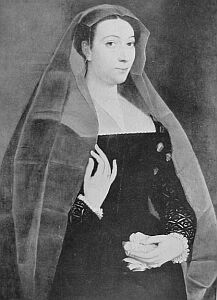  |
Colour and
material:
|
|
Red is a
common colour used in Florence (see The Colours of Florence)
I wanted to use a relatively plain material as the sleeves were
intricate. I did have some red damask in the stash (though the pattern
was not perfect). More information on the materials used in Florence
can be found HERE.
Unfortunately, I cannot afford silk damask and have to be content with
a synthetic/cotton mixture. |
Updated Research on Tailoring.
Following my trip to Florence and attending the Costume Colloquium, I
have done some fine tuning on my tailoring techniques. My original
article can be found HERE. An updated article is in
the works...
The main differences are:
- the wool stiffening of the imbusto is 3-6mm thick (I was
using 2mm).
- seams could be either flat fell or open and did not
necessarily have the edges hemmed down.
- the position of the 'side-back' lacing is more towards the
side, than the back.
- the armhole appears to be flat at the back pattern piece
and curved on the front.
- It appears that the upper class sottana has the skirt made
of pieced panels and the middle/everyday sottana could have a skirt
made with simple rectangles.
As a result, I planned to remake my toile for a basic dress.
Unfortunately time (and the need to remake my duplicate dress dummy)
did not allow for altering the 'side' lacing position. This will be
attempted next time. The sleeve pattern will be the same.
Method:
Bodice:
|
Below shows the bodice
pattern cut out and the lining herringbone stitched on. = Front and back
The layers of lining consisted of two layers of canvas/denimn =
stiffened material and 2 layers of wool felt = 4mm thick.
|
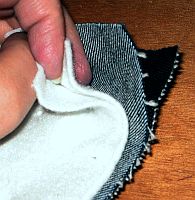 |
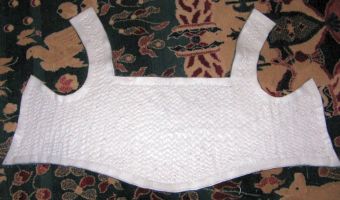 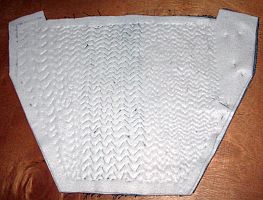
The layers were then cut where the seam would be and the edges of
the
outer material was folded over and sewn in place with running stitch.
The lining was then folded over, at the seam allowance, and hem
stitched to the back of the main bodice.
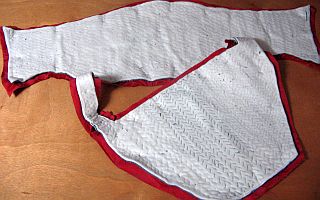 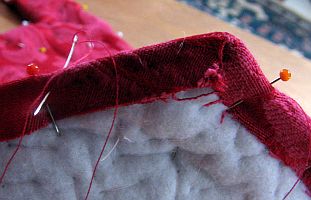
The final bodice was quite stiff. (below L) The eyelets were handsewn.
(below R)
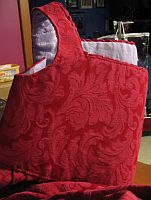 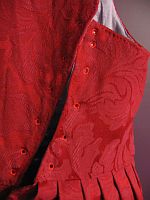 Skirt:
Skirt:
The skirt was cut in
triaangles and rectangles, to minimise material use. This is
consistent with the extant red dress, in Pisa, and with the burial
dress of Eleanora. I pleated the skirt, to minimise bulk (below L).
There are extant examples of pleating, such as the Wool/linen
dress in Pisa. (below middle). The seams were
flat-felled using running stitches (below R)
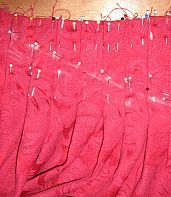 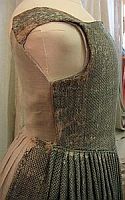 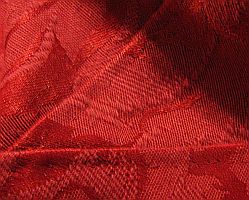
The skirt openings were edged with a bias strip, made from the same
material as previously discussed in Tailoring Techniques.
The hem was also edged with a bias strip (covering a felt strip).
This is again seen in the Red Pisa Dress (at the Florence Textile
Colloquium) and discussed in Janet Arnold's
Pattern of Fashion, with regards to Eleanora's burial dress.
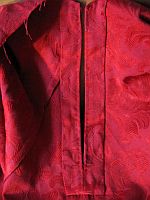 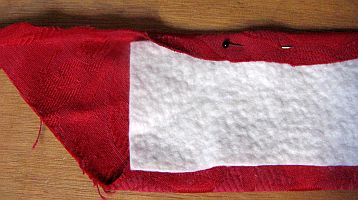
Below you can see how I attatched it to the lower hem. (left) and the
final, stiffened hem (works a treat!!)
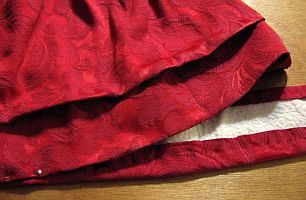 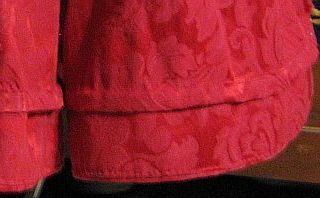
The pleated skirt was added to the bodice and the lower lining 'seam'
was hem stitched in place.
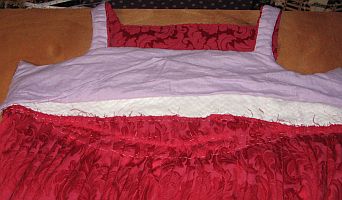
Sleeves: Cutwork pattern
I 'caved'
into a modern cheat here. I used a very thin iron-on
interfacing to try to stabilize the jacquard and reduce fraying on the
longer threads.
Below Left, is the cutwork pattern, based on the Guilia portrait, over
the interfacing.
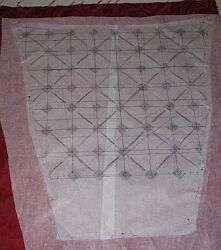 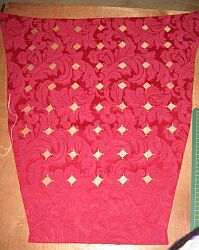 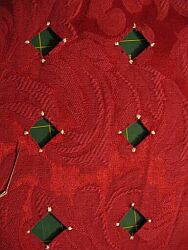
Above centre, is the sleeve with
the diamonds cut out. These are mostly
on the diagonal, so should again reduce fraying. I used 3-4 stitches of
silk embroidery floss at the corners of the diamonds to finish them off
and try to reduce fraying at these points. This is based on the
original portrait. If you look closely, there are little white 'points'
at the corners of the diamonds. My theory is that these could possibly
be stitches??
The buttons are thread covered buttons, as seen on the Red dress in
Pisa. (Below L, from notes supplied at the Textile Colloquium) Below
middle shows the (reconstructed?) closure as a loop (photo: K
Carlise); my final sleeves (below R)
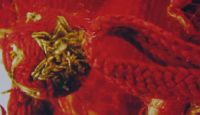 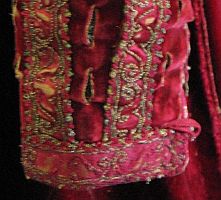 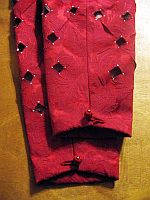 Decorations:
Decorations:
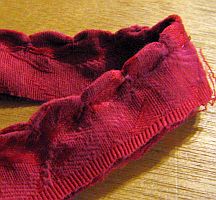 
|
The
neckline was decorated with a 'scalloped' type trim, instead of a cut
edging. This was seen in one of the original inspirations for this
dress, seen on the left. This was also the inspiration for the gold partlet.
|
The bodice is worn using long ties around the waist.
This is suggested in Moda a Firenze,
and works very well, with the bodice not moving nor having to be
adjusted at any time during the day/night!! The saccoccia are worn so
they can be easily accessed via the skirt openings.
 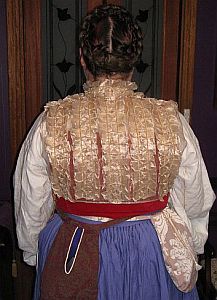
Finally, the dress as worn on the night.
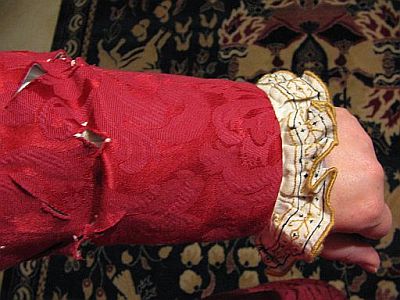 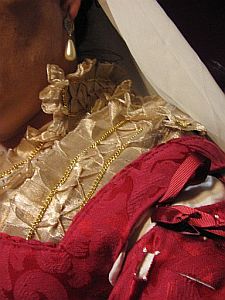
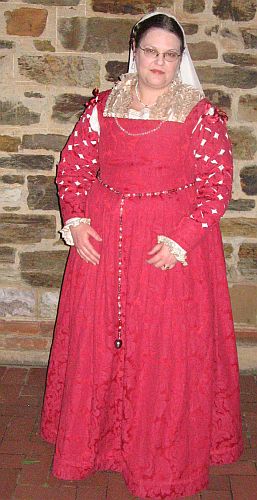
Conclusions:
The increased thickness of felt lining did indeed
stiffen up the bodice and give a flatter profile. However, due to my
pathetic modern posture and belly, there was still a crease by the end
of the evening. At the beginning of the evening, there was none.
If my posture was improved, then this would improve the flattness
of the bodice.
Bibliography:
- L'Abito della Granduchessa; Vesti di corte
di Madonne nel Palazzo Reale di Pisa. Museo Nazionale di
Palazzo Reale, Pisa
- McCorquodale,
Charles. Bronzino: Agnolo Bronzino.
Chaucer Press. London. 2005. ISBN:1-904449-48-4
- Orsi Landini, Roberta
& Niccoli, Bruna. La Moda a
Firenze 1540-1580. Pagliai Polistampa, Firenze, 2005. ISBN:
88-8304-867-9
- Rosenthal, Margaret F, Jones, Ann
Rosalind. Cesare Vecellio's Habiti
Antichi et Moderni: The Clothing of the Renaissance World.
Thames and Hudson, London. 2008. ISBN: 978-0-500-51426-9.
-
Notes and photos taken at
the Florence Textile Colloquium, 2008.
http://www.costume-textiles.com/pages/page.asp?lang=2&idcontent=46
http://www.costume-textiles.com/pages/images/costume_ppt_11_08.ppt
http://www.costume-textiles.com/pages/page.asp?idcontent=72&lang=2
(ha, proof I was there in photo #6!!)
(c)
June, 2008
|



|





































